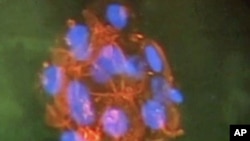Asians are beginning to warm up to the idea of using their own stem cells to treat a host of illnesses such as heart disease, cystic fibrosis or leukemia. Some parents are preserving their babies' umbilical cords, hoping that as technology advances their children can use the umbilical blood to cure future illnesses.
It is a nightmare for parents to hear their child has developed a disease that requires a bone marrow transplant. For instance, patients with leukemia, a type of blood cancer, sometimes have a hard time finding a bone marrow match.
Scientists say the umbilical cord that attaches a baby to its mother is a rich source of stem cells, which can treat diseases like leukemia. They can be collected immediately after birth and stored in freezers by companies such as Cordlife, which operates cord blood banks in Hong Kong, Singapore, Indonesia, India and the Philippines. If a child needs it, doctors can retrieve cord blood for treatment.
"We're seeing an explosion umbilical cord blood banking as a source of biological insurance for parents in Asia and their children," said Andrew Wu, Cordlife's technical and laboratory director.
Scientists around the world are finding new ways to use cord blood stem cells to treat problems such as spinal cord damage, diabetes, cerebral palsy and heart disease.
At Cordlife, parents pay about $4,000 to keep their children's cord blood for 18 years.
"I'm most excited to see the use of stem cell in therapy becoming a standard of care, where clinicians when they look at a disease would ask, 'What's my stem cell option in terms of therapy? How I can look to stem cells to treat this disease or regenerate this organ or to combat this tumor?'" Wu said.
Asia appears striding toward the use of stem cells for treatment.
Dr. Supachai Chaithiraphan, a professor emeritus of Thailand's Mahidol University and director of the cardiac center at Chao Phya hospital in Bangkok, conducted a clinical trial in 2004 that injected stem cells derived from human blood to treat people with end-stage heart disease.
"Eighty percent showed improvement in terms of New York Heart Association classification and also the Canadian [Cardiac Society] angina classification. So we feel that this group of patients can derive benefit from their own stem cell therapy," Supachai said.
In Asia, there are fewer regulations regarding the use of stem cells than in the United States, which encourages research and clinical uses.
In the U.S., the use of stem cells has been controversial because of ethical concerns over the use of embryonic stem cells - derived from early-stage embryos that develop from human eggs fertilized in a laboratory. Under President Bush, the government limited funding to a few batches of stem cell lines. But the Obama administration has since relaxed those rules.
However, cord blood storage appears to be increasing in the U.S. A new national cord blood bank has been established at Duke University in the state of North Carolina.
Some practitioners, such as Wu worry that Asia's lax regulations may lead to inflated expectations and false promises.
"A lot still needs to go into building this understanding and building appropriate regulations around the use of these stem cells so that the industry as a whole can develop within a legal framework that not only benefits the companies but most importantly benefits the clinicians and the patients at the end of the day," Wu said.
Poor medical facilities in some developing Asian nations also hold back use of stem cells.
But Supachai says in time, stem cell therapy will be more accessible.
"I would foresee that in the near future more doctors would come to realize that this cell therapy is really of help to certain number of patients with certain diseases, in particular heart disease," Supachai said.
The World Health Organization estimates that about 20 million people worldwide will die from cardiovascular disease annually by 2015. The number of people in developing nations suffering from heart disease is expected to rise as incomes increase.









